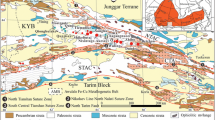Abstract
Based on research on the “Xinyu-type” Sinian iron deposits in Jiangxi Province and metamorphosed iron deposits in Jiangkou and Qidong of Hunan, Sanjiang and Yingyangguan of Guangxi, Longchuan of Guangdong and some other areas in Fujian, the authors have come to the following conclusions:
-
1.
The metamorphosed late Precambrian iron ores widespread in south China may be roughly assigned to two ore belts, namely the Yiyang-Xinyu (Jiangxi)-Jiangkou(Hunan)-Sanjiang (Guangxi) ore belt or simply the north ore belt, and the Songzheng(Fujian)-Shicheng (Jiangxi)-Bailing (Longchuan of Guangdong)-Yingyangguan (Guangxi) ore belt or the south ore belt. Tectonically, the former lies along the southern margin of the “Jangnan Old Land”, while the latter along the northwestern border of the “Cathaysian Old Land”.
-
2.
Iron deposits of this type occur exclusively in the same interglacial horizon of the Sinian Glaciation in south China. Above and below the ore bed there lie the glacial till-bearing volcanic-sedimentary layers.
-
3.
Based on sedimentary features, the iron formations can be divided into four types: silica-iron-basalt formation, silica-iron-clastic rock formation, silica-iron-tuff formation and silica-iron-carbonate rock formation, which progressively grade into each other.
-
4.
Iron ores were formed at the late stage of late Proterozoic rifting in neritic environments, with their distribution governed by the rift valleys on the margins of the “Jiangnan Old Land” and “Cathaysian Old Land”. Consequently, intense mafic volcanism as well as weathering and denudation of palaeocontinent during rifting provided material sources for the formation of iron deposits. Meanwhile, warm and humid stationary neritic environment during the south China great glacial period constitutes favorable palaeoclimatologic and palaeogeographic conditions for the deposition of iron ores.
-
5.
The iron formations have undergone regional metamorphism of greenschist-amphibolite facies.
To sum up, the late Precambrian banded iron ores should be of metamorphosed volcano-sedimentary type.
Similar content being viewed by others
References
Tang Jiafu, Deformation characteristics of metamorphic rocks and studies of metamorphic strata — on tectonic stratigraphy,Regional Geology of China, 1983 (Volume 4) (in Chinese).
Liu Hongyun et al.,Scientia Geologica Sinica, 4(1980) (in Chinese with English abstract).
Author information
Authors and Affiliations
Rights and permissions
About this article
Cite this article
Tang, J., Fu, H. & Yu, Z. Stratigraphy, type and formation conditions of the late precambrian banded iron ores in south China. Chin. J. of Geochem. 6, 331–341 (1987). https://doi.org/10.1007/BF02872262
Issue Date:
DOI: https://doi.org/10.1007/BF02872262




